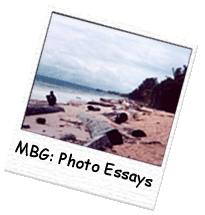 |
QUICK SEARCH
MO PROJECTS:
Africa
Asia/Pacific
Mesoamerica
North America
South America
General Taxonomy
Photo Essays
Training in Latin
America
MO RESEARCH:
Wm. L. Brown Center
Bryology
GIS
Graduate Studies
Research Experiences
for Undergraduates
Imaging Lab
Library
MBG Press
Publications
Climate Change
Catalog Fossil Plants
MO DATABASES:
W³MOST
Image Index
Rare Books
Angiosperm
Phylogeny
Res Botanica
All Databases
INFORMATION:
What's New?
People at MO
Visitor's Guide
Herbarium
Jobs & Fellowships
Symposium
Research Links
Site Map
Search
Introduction Introduction |
| Photo Essay Home | Begin Photo Essay | Outline | Photo Gallery | Search |

|
Gabon: Collecting for the Future Gabon: Collecting for the Future |
Contributor: Walters, Gretchen
Contributor: Stone, John
This photo essay chronicals the collection trips of two MBG botanists as they travel to Gabon in Central Africa.
Gabon is a small country located on the western coast of equatorial Africa. At 250,000 square kilometers, roughly the size of Colorado, the country contains more than 5,000 plant species. Traversed by vast tracts of virgin rainforest and smaller areas of savanna, it is one of the most species-rich tropical African countries. Seventy percent of the original forest remains intact even though timber is a primary export (http://www.globalforestwatch.org/english/gabon/index.htm). These competing interests make for interesting bedfellows as Gabon tries to balance conservation with economic growth.
Botanically, Gabon is one of the least studied countries in tropical Africa. The Missouri Botanical Garden (MBG) is therefore focusing its plant collecting efforts in the region, and has made numerous trips to Gabon in the last decade. Such research has resulted in discoveries of species new to science, provided data for conservation of critical habitats, and has strengthened collaborative relationships with other key conservation organizations active in Gabon.
For example, Mike Fay, of the Wildlife Conservation Society, brought international attention to the region during his recent Megatransect as well as making important ecological discoveries. As a result of such efforts, in September 2002, Gabon established 13 national parks. This unprecedented act of conservation (http://gabonnationalparks.com/gnp-home/gnp-pressrelease/) preserves 10% of Gabonís wilderness (more than 10,000 square miles). Of these parks, the Lope-Okanda Reserve is the most botanically well known, having been studied by MBG botanist Gordon McPherson.
For over 10 years, the MBG has been studying Central Africaís biodiversity. As part of our ongoing study of the regionís plant diversity, Gretchen Walters, John Stone, and Adam Bradley, botanists with the William L. Brown Center of Economic Botany, regularly travel to Gabon. Their mission is to collect plant samples for chemical screening by Sequoia Sciences as well as document Gabonís plant diversity with funding from the National Geographic Society. The following images are from these plant collecting expeditions.
© 1995-2025 Missouri Botanical Garden, All Rights Reserved
4344 Shaw Blvd.
St. Louis, MO 63110
(314) 577-5100
Technical Support